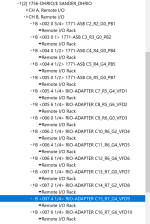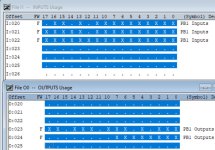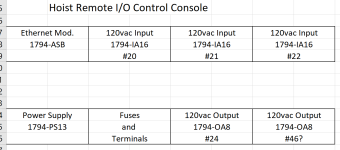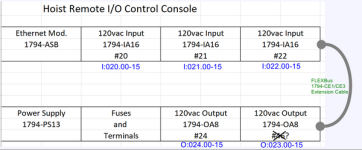ruairicussen
Member
The occasional times i have had to deal with blue hose/PLC5 I/O addressing it always wrecks my head. Now i am working on a ControlLogix program (L81E v34) using a 1756-DHRIO to integrate existing RIO currently controlled by a PLC5. The CLX local chassis (17 slot) has 1756 cards to connect all the PLC5 Local Chassis I/O (PLC5 was also a 17 slot local chassis). Local I/O is no problem, but i was hoping an expert could look at my control logix I/O tree RIO configuration and tell me if it looks right. I also have some confusion about how some of the "1 Slot" "2 Slot" I/O is coming in in the running PLC5 system. Attached are screenshots of the PLC5 Chassis Table and the Channel B RIO i added to the CLX I/O tree.
Question 1 - PLC5 Local Chassis is listed as 8 slots, actually 17. I assume this entry just doesn't matter for the PLC5 Local Chassis? The local chassis IO consumes I:000 - I:017
Question 2 - PLC5 Chassis 2 is set to "2 Slot" Addressing, but the Input and output data do Not use the same locations in the Input and Output Files [PLC5_Rack2_IO pic attached]
Question 3 - PLC5 Chassis 7-16 are set to "1 Slot" Addressing, but the Input and Output Data DO use the same locations in the 2 IO files ("Span" of only 2 Groups, but there are 2 words each of Input and Output Data) [PLC5_Chassis16_IO pic attached]. Only attached one but they are all similar. These are 1336's via 1336-GM1 RIO adapters.
Question 4 - is generic "RIO ADAPTER" the right adapter to use in the CLX I/O tree under ChannelB of the DHRIO to represent a 1336 with a 1336-GM1 adapter? or is there a module profile i should be adding to studio? I would not be too worried about this if the "2 Slot" addressing of those Chassis in the PLC5 did not seem to act differently than the "2 Slot" addressing of Chassis 2 in the PLC5. There seems to be very little config available on the 1756-DHRIO side of things.
Question 5 - is there any change to LSB MSB order of I/O under the 2 systems, or anything else like that that would be a major mistake to assume the IO data will come in to the same bit in the CLX words as it does in the PLC5 words?
In my confused brain i cannot find a single thing here where one chassis setup vs. result does not contradict another chassis setup vs. result in the PLC5 RIO.
Thank You in Advance for any assistance,
Ruairi








